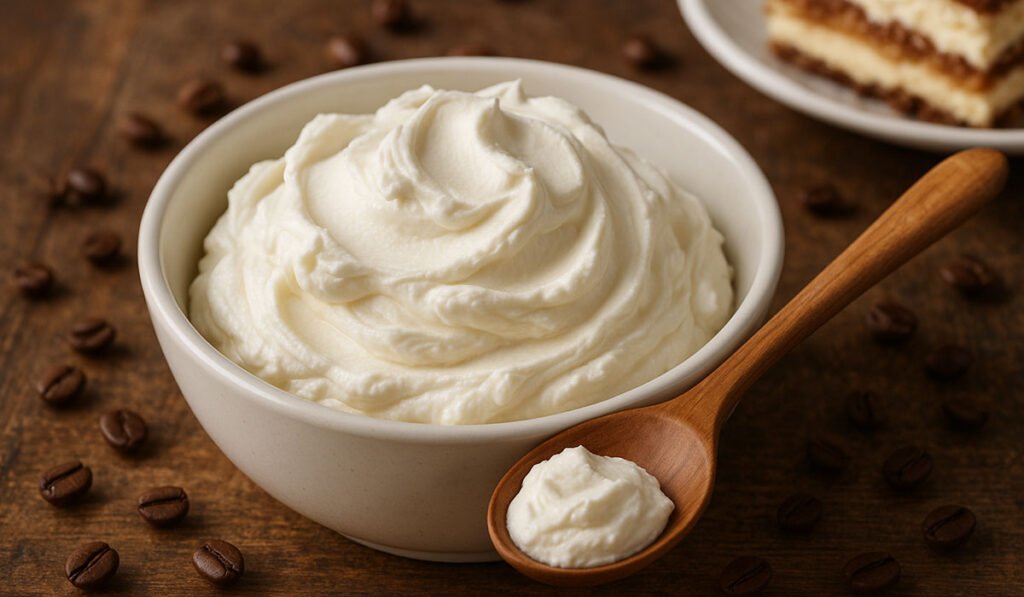Table of Contents
ToggleWhat Is Mascarpone?
Imagine a cloud-like, creamy cheese that’s both rich and delicate. That’s mascarpone. It’s a fresh Italian cheese that has a knack for making good dishes great, whether they’re sweet or savory.
This cheese hails from the Lombardy region of Northern Italy, with a story that goes back centuries. The name “mascarpone” is thought to come from “mascarpa,” a local dialect word for a type of ricotta, though they are two very different cheeses.
What’s interesting is how it’s made. Unlike cheeses that start with milk, mascarpone begins with fresh heavy cream. The cream is gently heated, and a bit of acid, like lemon juice, is added. This simple step thickens the cream, and after draining away the whey, what’s left is a thick, velvety cheese that’s ready to be enjoyed.
The Signature Taste and Texture
Mascarpone’s charm lies in its unique taste and feel. It has a subtle, milky sweetness with a slight tang that brightens its rich flavor. This gentleness allows it to complement other ingredients without stealing the show.
But the texture is where it truly shines. With a high fat content of 60-75%, mascarpone is incredibly decadent. It’s smooth and velvety, a texture that feels luxurious and melts in your mouth. This quality makes it a fantastic ingredient for adding a touch of elegance to any recipe.
This blend of a mild flavor and a rich texture makes mascarpone a go-to ingredient for chefs and home cooks alike, perfect for adding a bit of sophistication to their dishes.
The Culinary Versatility of Mascarpone
In the kitchen, mascarpone is wonderfully versatile. It can be used in all sorts of dishes, adding a creamy, luxurious touch wherever it goes.
Of course, the most famous use for mascarpone is in tiramisu. It’s the heart of the dessert, creating the light, creamy layers that make it so iconic.
But mascarpone is no one-trick pony. In savory dishes, a spoonful can turn a basic pasta sauce or risotto into something special. It can be stirred into mashed potatoes for extra creaminess or used as a base for rich dips.
For those with a sweet tooth, mascarpone is a dream. It makes for luscious frostings, fillings for tarts, and the base of no-bake cheesecakes. Its stability and creamy nature make it a reliable choice for any dessert that needs a smooth, rich element.
Mascarpone vs. Cream Cheese: A Common Comparison
People often group mascarpone and cream cheese together, but they’re quite different. Both are creamy, but that’s where the similarities end.
Cream cheese is made from whole milk, which gives it a firmer texture and a distinct tangy taste. Mascarpone, on the other hand, is made from heavy cream, which gives it a much higher fat content and a looser, more velvety feel. Its flavor is also sweeter and more subtle.
When you look at the numbers, mascarpone has a fat content of 60-75%, while cream cheese is much lower at around 33%. This is why mascarpone feels so much richer. While you can sometimes swap one for the other, it will change the dish. Mascarpone brings richness, while cream cheese adds a tangy kick.
Nutritional Insights
There’s no denying that mascarpone is a treat. It’s high in calories and fat, so it’s something to be enjoyed in moderation. The good news is that a little goes a long way in adding flavor and richness.
It’s a good source of energy, and it also provides some protein and calcium. The fat in mascarpone can also help your body absorb vitamins like A, D, E, and K when you eat it with foods that contain them.
Think of mascarpone as an indulgence. It’s a food that can bring a lot of pleasure and satisfaction to a meal, which is a key part of enjoying what you eat.
How to Store Mascarpone
To keep your mascarpone fresh, proper storage is essential. Once you open it, keep it in an airtight container in the fridge and try to use it within a week.
If you need to store it longer, you can freeze it for up to two months. Just put it in a freezer-safe container, and when you’re ready to use it, let it thaw in the fridge. The texture might change a bit, but it will still be great for cooked dishes.
It’s also good to know when it’s past its prime. If it smells sour, looks yellow instead of creamy white, or has any mold, it’s time to toss it.













